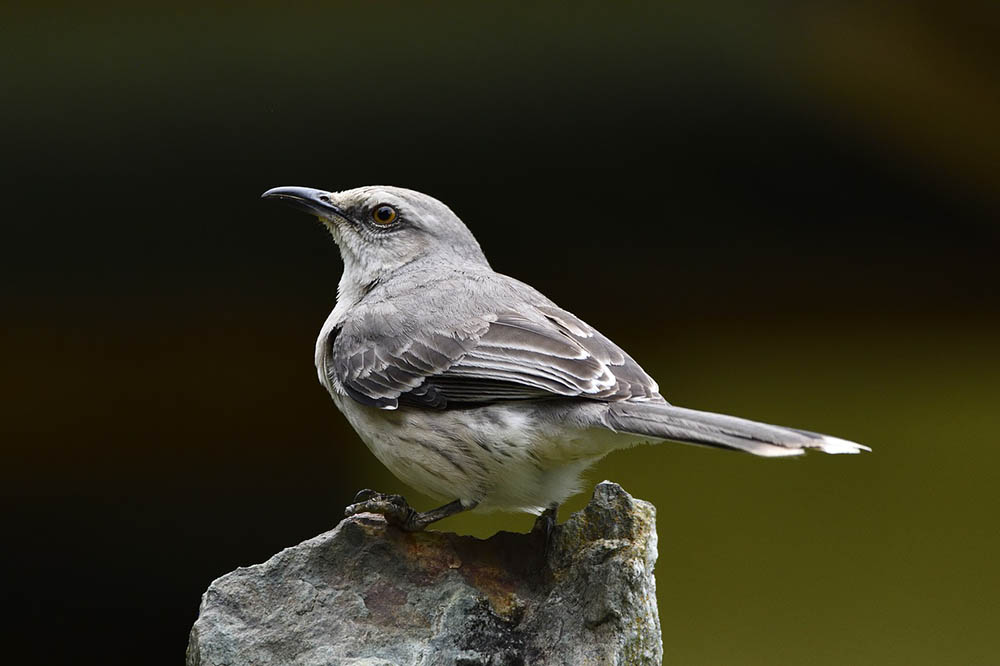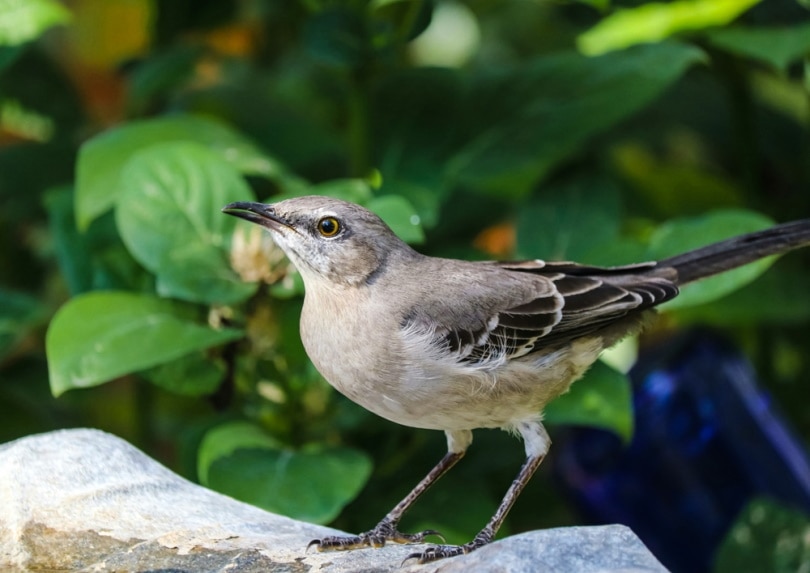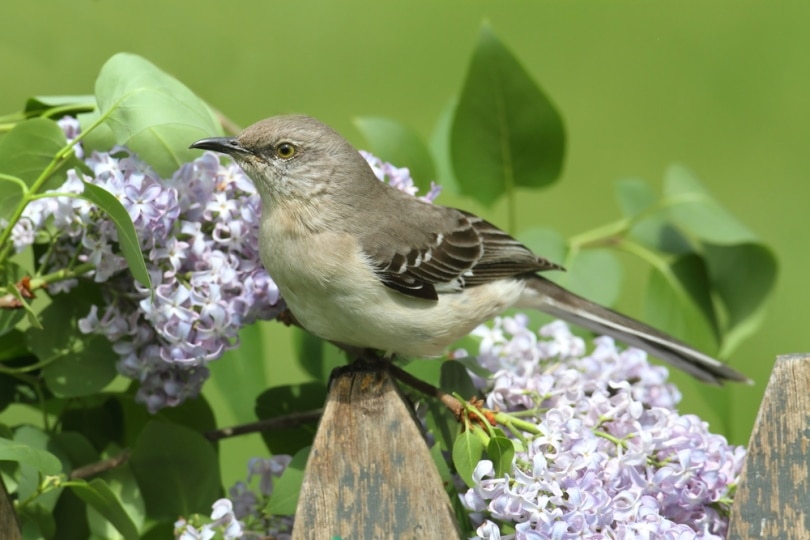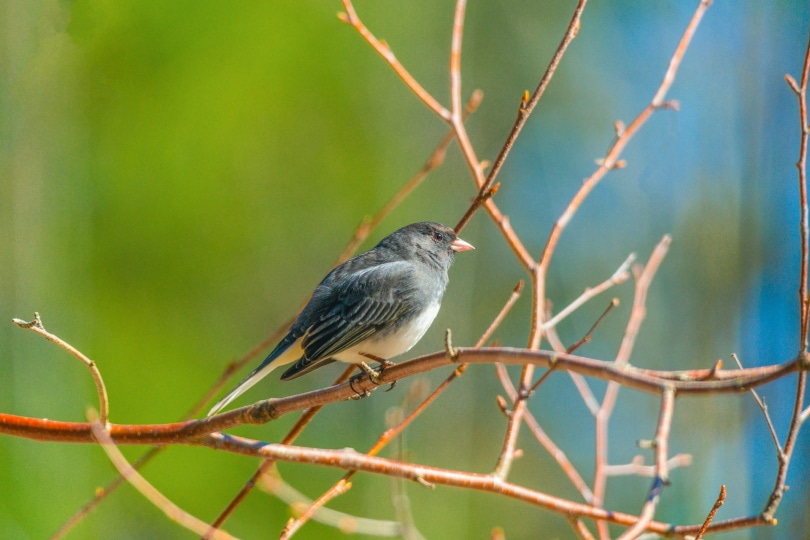10 Interesting & Fun Mockingbird Facts You Never Knew
Last Updated on

The Northern Mockingbird is a passerine bird, also called a perching bird. They are found throughout the US and in parts of Mexico and Canada. Some mockingbirds migrate south for winter, but only those in the northeast part of the Continental United States.
The Northern Mockingbird is best known for its incredible mimicry, and not only does this songbird have its own distinct call, but it can imitate dozens of calls of other birds, animals, and even the noise of car alarms, chainsaws, and more. Listed below are 10 facts about the Northern Mockingbird.

The 10 Interesting and Fun Mockingbird Facts You Never Knew
The Mockingbird’s Mocking
1. Its Latin Name, Mimus Polyglottos, Means “Many-Tongued Mimic”
Mockingbirds are a group of 17 species found throughout the world. The Northern Mockingbird is the one most commonly thought of when referring to the mockingbird and is the species found in North America. It is a gray-brown color with white wing bars and a lighter belly and chest. It grows to approximately 10 inches in length and can weigh as much as 2 ounces.
The Latin name for this songbird is Mimus Polyglottos, which means “many-tongued mimic” and indicates the bird’s incredible ability to mimic the calls of other birds and the noises it hears.

2. They Can Make 200 Different Noises and Mock a Range of Other Noises
The Northern Mockingbird does have a call of its own, which is not copied from other birds. Whether it is singing its own unique song or copying those of others, the species is known for being loud and for singing at any time of the day throughout the year.
In total, it is believed that mature mockingbirds can make as many as 200 distinct noises and calls and will usually repeat them up to a dozen times.
3. Males Learn New Calls Every Year
Although females and males sing, it is the male mockingbird that has the greater range, and they sing more often than the females. It is believed that male mockingbirds learn new calls every year while maintaining around 50% of the calls they learned in the previous year. The bird lives approximately 7–8 years, adding to their repertoire every year.

4. The Mocking Doesn’t Fool Other Animals and Is Likely Done to Impress a Mate
The mimicked calls of the Northern Mockingbird do not fool other mockingbirds or animals. So, when a mockingbird copies the song of a cardinal, the cardinal knows that it is a mockingbird making that noise.
For this reason, and because males can imitate a greater range of noises, it is believed that mimicking is performed as a means of attracting a mate and not to deter the animal it imitates.
Mockingbird Popularity
5. The Mockingbird Inspired the Mockingjay in The Hunger Games
The mockingbird’s incredible vocal prowess not only means that it can be found in dozens of animal videos and all over social media, but it has inspired films. The Mockingjay, which features as a central theme in The Hunger Games books and films, is inspired by the songbird.
In The Hunger Games lore, the Mockingjay was a result of breeding between the fictional Jabberjay and the very real mockingbird.

6. The Mockingbird Is the State Bird for Five States
The Northern Mockingbird is also popular with officials across the US, having been chosen as the official state bird for Arkansas, Florida, Mississippi, Tennessee, and Texas. On officially declaring the Northern Mockingbird as its state bird in 1927, Texas officials said that they chose the bird because it will protect its home with its life if necessary.
7. The Illegal Pet Trade Reduced the Mockingbird’s Numbers in the 19th Century
The vocal range and skills of the mockingbird have seen it become a very popular bird, but in the 19th Century, the illegal trade of this species saw its numbers dwindle. At this time, the most skilled singers could fetch $50–the equivalent of more than $1,200 in today’s money. Fortunately, the bird is highly adaptable, and it not only recovered in numbers but has since thrived. It is not considered to be under threat of extinction.
Mockingbird Behavior
8. They Have Adapted to Live in Built-Up Areas
The expansion of human habitats and cities has seen a lot of birds suffer, especially those that prefer open spaces and shy away from humans. The mockingbird is highly adaptable. It is omnivorous and will find food in most climates and conditions.
Some scientists believe that the bird can tell individual people apart and will adapt their behavior around people according to their perceived threat level. This has helped them survive and flourish in towns and cities.

9. Mockingbirds Have Been Known to Attack People When Defending Territory
Typically, a mockingbird’s response to danger is to fly away, but if they feel their territory and young are threatened, the mockingbird will defend and even attack potential predators. This can include humans. Because the bird can also recognize humans the next time they see them, this means that they will attack again in the future when they see a threat.
10. The Mockingbird Uses Its White Patches to Deter Predators
The mockingbird may be best known for its mimicry and its loud vocalizations, but it can be recognized by keen spotters thanks to its gray-blue coloring and white patches on its wings. These patches are more than decorative, and when swooping at potential predators, the birds use the white flashes as a means of deterring attack.
Conclusion
The mockingbird is a songbird that has the ability to mimic as many as 200 different calls and noises. It can even copy car alarms and saws, as well as other birds and animals in its habitat. Although it was once thought that the birds mimicked other animals in a bid to deter them, modern theories suggest that the animals they mimic can tell the difference and that the noises are made as a means of attracting a mate.
You might Interested:
- Interesting and Fun Northern Cardinal Facts
- Interesting and Fun Cooper’s Hawk Facts
- Interesting & Fun Facts About Woodpeckers
Featured Image Credit: Hippo_Lytos, Pixabay
About the Author Robert Sparks
Robert’s obsession with all things optical started early in life, when his optician father would bring home prototypes for Robert to play with. Nowadays, Robert is dedicated to helping others find the right optics for their needs. His hobbies include astronomy, astrophysics, and model building. Originally from Newark, NJ, he resides in Santa Fe, New Mexico, where the nighttime skies are filled with glittering stars.
Related Articles:
10 Types of Hummingbirds in Arkansas (With Pictures)
8 Types of Hummingbirds in Nebraska (With Pictures)
5 Types of Hummingbirds in Idaho (With Pictures)
3 Types of Hummingbirds in Mississippi (With Pictures)
8 Types of Hummingbirds in Kansas (With Pictures)
5 Types of Hummingbirds in West Virginia (With Pictures)
5 Types of Hummingbirds in Ohio (With Pictures)
Where Do Nuthatches Nest? Nuthatch Nesting Habits Explained
